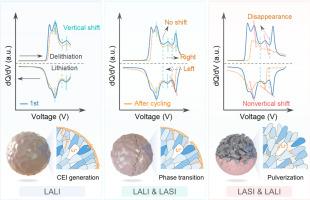当前位置:
X-MOL 学术
›
Energy Storage Mater.
›
论文详情
Our official English website, www.x-mol.net, welcomes your
feedback! (Note: you will need to create a separate account there.)
Looking into failure mode identification driven by differential capacity in Ni-rich layered cathodes
Energy Storage Materials ( IF 18.9 ) Pub Date : 2024-11-18 , DOI: 10.1016/j.ensm.2024.103914 Xiaodong Zhang, Ersha Fan, Jiao Lin, Yi Zhao, Qingrong Huang, Su Ma, Renjie Chen, Feng Wu, Li Li
Energy Storage Materials ( IF 18.9 ) Pub Date : 2024-11-18 , DOI: 10.1016/j.ensm.2024.103914 Xiaodong Zhang, Ersha Fan, Jiao Lin, Yi Zhao, Qingrong Huang, Su Ma, Renjie Chen, Feng Wu, Li Li

|
Nickel-rich layered cathodes are one of the ideal electrode materials for high-energy lithium-ion batteries, yet suffer from capacity decay and structural degradation during cycling. Although the degradation mechanisms of electrode materials are flourishing, the analysis of performance decay and physicochemical properties dynamic evolution during cycling have not been well developed. Here, we propose a coupling analysis strategy based on differential capacity that distinguishes the failure behavior of electrode materials during cycling by the characteristic evolution of the dQ dV –1 curve recorded cycle-by-cycle. By coupling in-situ electrochemical tests with differential capacity characterization and comparing them with electrochemical characteristics recorded at different aging upper cut-off voltages cycles, the capacity decay mechanism and physicochemical properties evolution of electrode materials can be dynamically analyzed. The potential failure modes include loss of active Li inventory (LALI), loss of active structure integrity (LASI), and various dominant combinations of these factors. In addition, the distinction of aging behavior can also be applied to the failure level classification of spent electrode materials. Our findings demonstrate a general strategy for analyzing the dynamic failure mechanisms of electrode materials, thereby offering valuable insights for subsequent technology route selection in terms of recycling and reuse.
中文翻译:

研究由富镍层状阴极中的差容量驱动的故障模式识别
富镍层状阴极是高能锂离子电池的理想电极材料之一,但在循环过程中会出现容量衰减和结构退化。尽管电极材料的降解机制蓬勃发展,但对循环过程中性能衰减和物理化学性质动态演变的分析尚未得到很好的发展。在这里,我们提出了一种基于差分容量的耦合分析策略,该策略通过逐周期记录的 dQ dV-1 曲线的特征演变来区分电极材料在循环过程中的失效行为。通过将原位电化学测试与差分容量表征耦合,并将其与不同老化上限截止电压周期记录的电化学特性进行比较,可以动态分析电极材料的容量衰减机制和物理化学性质演变。潜在的失效模式包括活性锂库存损失 (LALI)、活性结构完整性损失 (LASI) 以及这些因素的各种主要组合。此外,老化行为的区分也可以应用于废电极材料的失效等级分类。我们的研究结果展示了分析电极材料动态失效机制的一般策略,从而为后续回收和再利用方面的技术路线选择提供有价值的见解。
更新日期:2024-11-18
中文翻译:

研究由富镍层状阴极中的差容量驱动的故障模式识别
富镍层状阴极是高能锂离子电池的理想电极材料之一,但在循环过程中会出现容量衰减和结构退化。尽管电极材料的降解机制蓬勃发展,但对循环过程中性能衰减和物理化学性质动态演变的分析尚未得到很好的发展。在这里,我们提出了一种基于差分容量的耦合分析策略,该策略通过逐周期记录的 dQ dV-1 曲线的特征演变来区分电极材料在循环过程中的失效行为。通过将原位电化学测试与差分容量表征耦合,并将其与不同老化上限截止电压周期记录的电化学特性进行比较,可以动态分析电极材料的容量衰减机制和物理化学性质演变。潜在的失效模式包括活性锂库存损失 (LALI)、活性结构完整性损失 (LASI) 以及这些因素的各种主要组合。此外,老化行为的区分也可以应用于废电极材料的失效等级分类。我们的研究结果展示了分析电极材料动态失效机制的一般策略,从而为后续回收和再利用方面的技术路线选择提供有价值的见解。

































 京公网安备 11010802027423号
京公网安备 11010802027423号